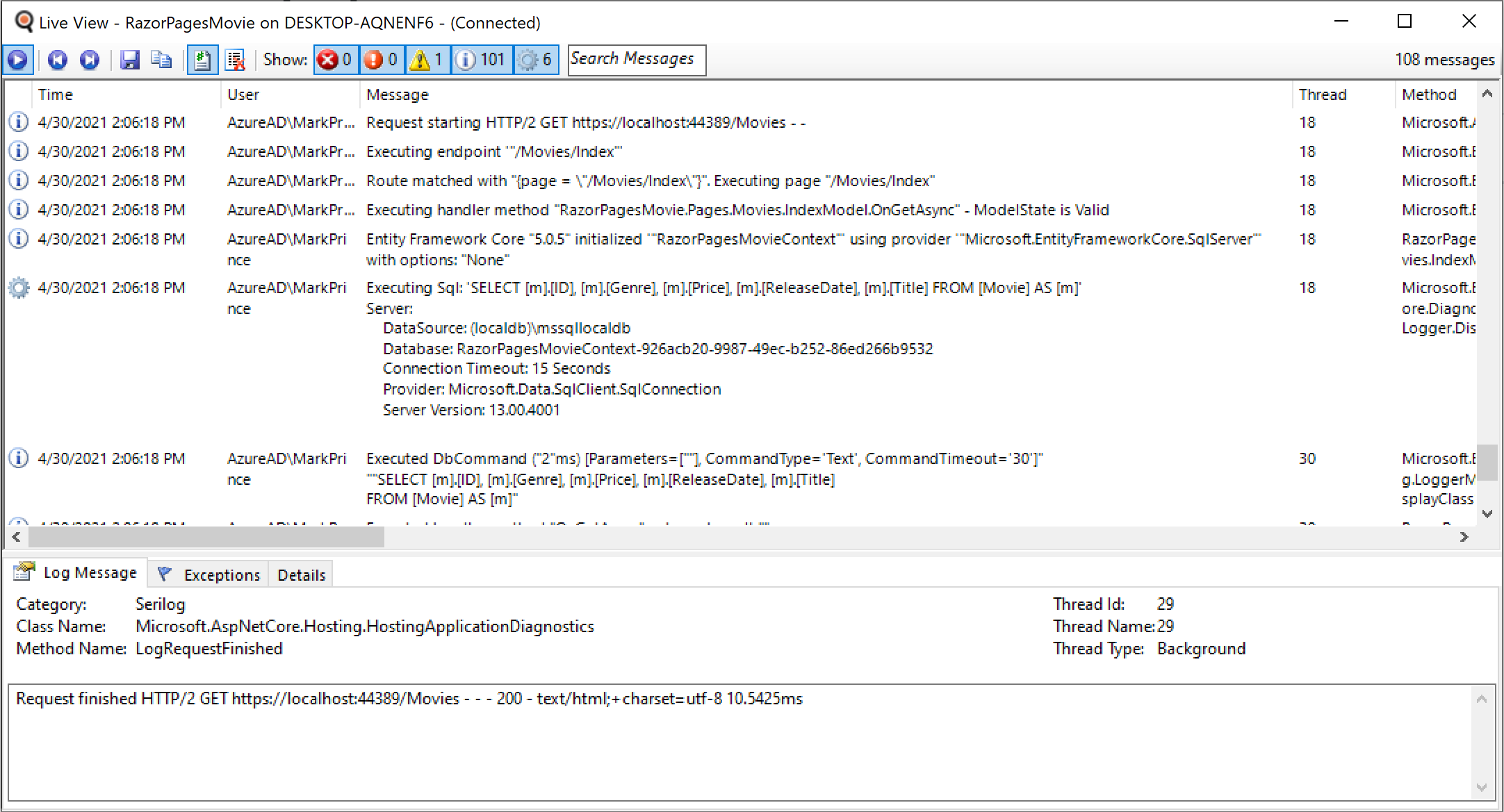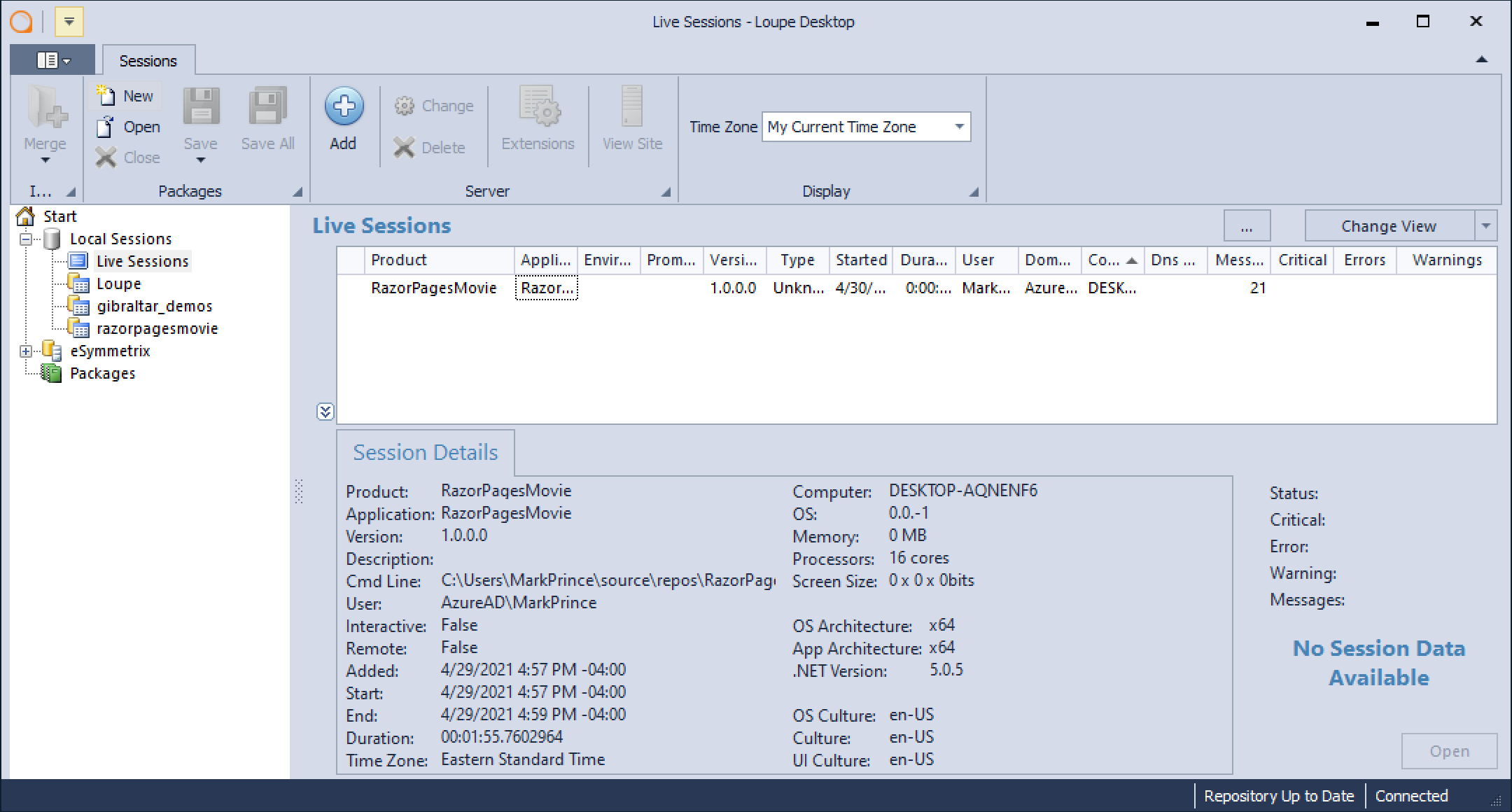Want a Free, Real-Time Log Viewer for .NET?
| Last Update | November 10th 2021 |
This article was written to discuss .NET 5, but the same tools used here work on .NET 6 as well! You can read more about Loupe .NET 6 support here.
I have been testing Loupe on .NET 5 recently and have grown to appreciate one of our features: the live session viewer. It is a real-time log viewer included in Loupe Desktop, a free log viewer that can be used for local .NET applications or remote applications connected to Loupe Server (our logging SaaS).
Viewing Live Session Data in Loupe Desktop
You can view live sessions for your application locally by going into the local sessions tab and clicking “Live Sessions.” In the live session viewer, you can filter logs by severity, use text search to find specific logs, export session data to a file or email, and more. You can also jump to the first or most recent log in the session, or pause the viewer to focus on a specific dataset.

In the screenshot above, I am viewing the logs for a Razor Pages application on .NET 5. I can watch the executed SQL commands done by my application as I click through the Razor Pages site, thanks to the Loupe Agent for Entity Framework Core.
As for .NET 5 support right now, the Loupe Agent supports ASP.NET, Entity Framework, WinForms, and WPF. Of course, you can also use it with .NET Core and .NET Framework.
How to Get Started
To try out a real-time log viewer for your applications, you can install Loupe Desktop for free and use it to view any local application sessions by just adding the appropriate Loupe agent to your project.
For .NET 5 specifically, you can follow along our documentation to add the loupe agent to your project. In short, you install the necessary nuget packages, add the following lines of code in the program.cs:
public static IHostBuilder CreateHostBuilder(string[] args) =>
Host.CreateDefaultBuilder(args)
.AddLoupe(builder => builder.AddEntityFrameworkCoreDiagnostics()
.AddPerformanceCounters())
.AddLoupeLogging();
And then add the following to your appsettings.json:
"Loupe": {
"Publisher": {
"ProductName": "Your Product", //Name of your project
"ApplicationName": "Your Application", //Name of specific application
"ApplicationType": "AspNet",
"ApplicationVersionNumber": "1.0.1"
},
Once I have done that, I can now run my application and see it appear in the Loupe Live Session menu for local sessions.

Do I Need a Real-Time Log Viewer?
It honestly depends. For some users, it is more of a convenience than a need. I am primarily working on applications for demos and some web dev. For my circumstances, this is more of an “icing on the cake” feature than a need. I keep the demo apps purposefully simple (aka very easy to break and fix), and for any web dev I’m asked to do the browser console is good enough. Even then, it does save me some time and helps “connect the dots” between what the user does in an application and what happens on the application side. So while I wouldn’t say I need it, it’s a low opportunity cost addition that I have found helpful.
For others, reading the data from a live session can save a significant amount of time when troubleshooting an issue or assisting a user. Knowing the exact problem a user is running into in real-time can help you solve their problem or find a workaround faster than if you needed to wait for the session to end. In general, the more time sensitive the troubleshooting is, the more helpful real-time log viewing will be.
Real-time Log Viewing vs. Log Monitoring
One thing to point out is that the utility of a real-time log viewer is different from that of a real-time log monitoring system, even if they seem to accomplish similar things at first blush. You may have an active need for one, but not the other.
-
Real-time log monitoring is about sending issue alerts to ensure developers know when an error occurs for a specific application. Generally, real-time log monitoring is most critical for production environments and connected to a centralized logging system. Getting one of these systems is likely a decision that requires the organization to be on board.
-
Real-time log viewing doesn’t alert you of anything you are not already watching. It is more useful for active development or diving deeper into a known issue—not having to wait for the session to end to access your log data allows for more fluid troubleshooting and faster response times in critical situations. Additionally, you can easily start using a real-time log viewer independently without incorporating it into the whole organization’s workflow.
The takeaway here is, both can provide live feedback to a problem but are appropriate for different times during troubleshooting. When you are developing an application locally on your machine or digging into an active issue, real-time log viewing shines.
Where Do I Get Loupe Desktop?
If you are a Loupe Server user, you can follow these directions to download and configure Loupe desktop for your service. The live session viewer will work for remote services, and it’s a feature not available through the browser. If you’re not a Loupe Server user, you can visit the page in the link below to learn more about Loupe Desktop and download it for free.